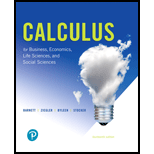
Problems 91–94 refer to the following: If a decrease in demand for one product results in an increase in demand for another product, the two products are said to be competitive, or substitute,
products. (Real whipping cream and imitation whipping cream are examples of competitive, or substitute, products.) If a decrease in demand for one product results in a decrease in demand for another product, the two products are said to be complementary products. (Fishing boats and outboard motors are examples of complementary products.) Partial derivatives can be used to test whether two products are competitive, complementary, or neither. We start with demand functions for two products such that the demand for either depends on the prices for both:
The variables x and y represent the number of units demanded of products A and B, respectively, at a price p for 1 unit of product A and a price q for I unit of product B. Normally, if the price of A increases while the price of B is held constant, then the demand for A will decrease; that is, fp(p, q) < 0. Then, if A and B are competitive products, the demand for B will increase; that is, gr(p, q) > 0. Similarly, if the price of B increases while the price of A is held constant, the demand for B will decrease; that is, gq(p, q) < 0. Then, if A and B are competitive products, the demand for A will increase; that is, fq(p, q) > 0. Reasoning similarly for complementary products, we arrive at the following test:
Test for Competitive and Complementary Products
| Partial Derivatives | Products A and B |
| fq(p, q) > and gp(p, q) > 0 | Competitive (substitute) |
| fq(p, q) < and gp(p, q) < 0 | Complementary |
| fq(p, q) ≥ and gp(p, q) ≤ 0 | Neither |
| fq(p, q) ≤ and gp(p, q) ≥ 0 | Neither |
Use this test in Problems 91-94 to determine whether the indicated products are competitive, complementary, or neither.
92. Product demand. The daily demand equations for the sale of brand A coffee and brand B coffee in a supermarket are
Want to see the full answer?
Check out a sample textbook solution
Chapter 7 Solutions
Pearson eText for Calculus for Business, Economics, Life Sciences, and Social Sciences -- Instant Access (Pearson+)
- 5. Find the derivative of f(x) = 6. Evaluate the integral: 3x3 2x²+x— 5. - [dz. x² dx.arrow_forward5. Find the greatest common divisor (GCD) of 24 and 36. 6. Is 121 a prime number? If not, find its factors.arrow_forward13. If a fair coin is flipped, what is the probability of getting heads? 14. A bag contains 3 red balls and 2 blue balls. If one ball is picked at random, what is the probability of picking a red ball?arrow_forward
- 24. What is the value of ¿4, where i 25. Simplify log2 (8). = −1? 26. If P(x) = x³- 2x² + 5x - 10, find P(2). 27. Solve for x: e2x = 7.arrow_forward9. Solve the differential equation: 10. Find the general solution of dy + y = 0. dy 33 dx 3x².arrow_forward3. Differentiate f(x) = x² sin(x). 4. Evaluate the limit: sin(2x) lim xarrow_forward
- 1. Solve for x in the equation: 2. If A = (1/3 2/) 4 x³-3x²+4=0 find the determinant of A.arrow_forwardListen ANALYZING RELATIONSHIPS Describe the x-values for which (a) f is increasing or decreasing, (b) f(x) > 0 and (c) f(x) <0. y Af -2 1 2 4x a. The function is increasing when and decreasing whenarrow_forwardBy forming the augmented matrix corresponding to this system of equations and usingGaussian elimination, find the values of t and u that imply the system:(i) is inconsistent.(ii) has infinitely many solutions.(iii) has a unique solutiona=2 b=1arrow_forward3/4+1/2=arrow_forwardif a=2 and b=1 1) Calculate 49(B-1)2+7B−1AT+7ATB−1+(AT)2 2)Find a matrix C such that (B − 2C)-1=A 3) Find a non-diagonal matrix E ̸= B such that det(AB) = det(AE)arrow_forward1.2.17. (!) Let G,, be the graph whose vertices are the permutations of (1,..., n}, with two permutations a₁, ..., a,, and b₁, ..., b, adjacent if they differ by interchanging a pair of adjacent entries (G3 shown below). Prove that G,, is connected. 132 123 213 312 321 231arrow_forwardarrow_back_iosSEE MORE QUESTIONSarrow_forward_ios
 Linear Algebra: A Modern IntroductionAlgebraISBN:9781285463247Author:David PoolePublisher:Cengage Learning
Linear Algebra: A Modern IntroductionAlgebraISBN:9781285463247Author:David PoolePublisher:Cengage Learning

